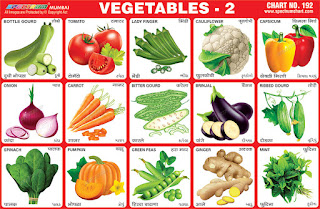Bottle Gourd – Bottle
Gourd is light green in colour and long, flesh inside is spongy &
white in colour. It contains over 90% water therefore it is easy to
digest. They are extremely popular for weight loss, reducing high
blood pressure and keeping your heart healthy.
Tomato - Tomatoes are
generally red in colour & round in shape. Tomatoes are rich in
lycopene, an antioxidant that is good for the heart and effective
against certain cancers. China is the largest producer of Tomato
followed by USA & India.
Lady Finger - Due to its
shapes resemblance it is known as Lady Finger in many countries. In
India it is known as Bhendi. It is green in colour. It is a popular
health food due to its high fibre, vitamin C and folate content.
Cauliflower - Cauliflowers
are large vegetables that belongs to the cabbage family. It is low
in calories and carbs. It provides important nutrients such as iron
and potassium.
Capsicum - Capsicum come in
various colours, such as green (unripe), red, yellow, and orange.
Fresh, raw capsicum are mainly composed of water (92%). The rest is
made up of carbohydrates and small amounts of protein and fat.
Onion - Onions are low in
calories, it is a good, healthy vegetable particularly when eaten
raw. There are approximately 325 different varieties of onions, most
popular types are Red Onion, Yellow Onion and Spanish Onion.
Carrot - Carrots are
usually orange in colour, vary in size and have fresh, green leafy
tops. Carrots are low in calories, and a very good, healthy
vegetable particularly when eaten raw.
Bitter Gourd - Bitter
Gourd, also known as bitter melon or karela (in India), is a unique
vegetable that can be used as food or medicine. It is a vine of the
Cucurbitaceae family and is considered the most bitter among all
vegetables.
Brinjal - Brinjal is a
purple vegetable full of nutrition that belongs to the nightshade
family. Brinjal are rich in fibre, potassium, vitamin B-6 and
phytonutrients like flavonoids, this vegetable lowers the risk of
heart disease.
Ribbed Gourd – Ribbed
Gourd are used as cooked vegetables or pickled or eaten raw. Ribbed
Gourd are used as natural cleaning sponges. Its fruit slightly
resembles a cucumber or zucchini.
Spinach – Spinach is a
green leafy vegetable. Spinach has many health promotional and
disease prevention properties. Spinach leaves are an excellent
source of vitamin K. Its also contain a good amount of minerals like
potassium, manganese, magnesium, copper and zinc.
Pumpkin - Pumpkins are
usually orange but can sometimes be yellow, white, green or red &
usually shaped like a sphere (ball). They vary in weight but an
average sized pumpkin might weigh around 6 kilograms.
Green Peas - Green Peas are
a small round leguminous vegetables that grow in a row, inside a
pod. The nutritional value of green peas is very high as they are
bursting with vitamins, mineral and nutrients.
Ginger - Ginger is commonly
used as a cooking spice throughout the world. It has been used to
help digestion, reduce nausea and help fight the flu and common
cold.
Mint - Mint, the well known
mouth and breath freshener. Mint is a great appetiser or palate
cleanser and it promotes digestion. The strong aroma of mint is very
effective in clearing up congestion of the nose, throat, bronchi and
lungs.


No comments:
Post a Comment